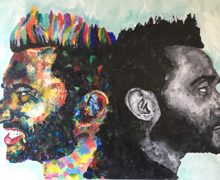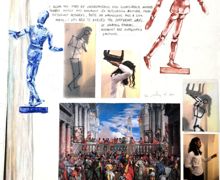- Home
- Sixth Form
- Curriculum
- Art
Art
Art and Design A-level students complete AQA Art and Design A-level. This comprises of two units of work: Coursework which is broken into several individual topics together making up 60% of the final grade and the Exam unit worth 40% of the final grade.
The students are required to write an Extended Contextual Essay of between 1000-3000 words as part of the coursework unit which discusses the influences and critical understanding of photographers they have studied during their independent projects.
Art and Design is a popular A-Level choice which is respected by all universities because it gives you the knowledge and skills necessary for higher education and which are also useful in any career. Students who specialise in Art and Design can go onto career paths like Architecture, Engineering, Graphic Design, Illustration and Animation.
Throughout the A Level course, students are guided through 1 set topic of exploration to enhance their skill set as they progress to their final personal projects.
Topic 1: Techniques, Artists and Genres Project.
This is an introductory Unit exploring different materials and processes whilst building students skills in a range of media and developing knowledge of artists and starting points. The aim of this unit is to develop individual skills and establish students core areas of interest and strengths.
Topic 2: Personal projects
Students begin Personal Projects in January of year 12 and students will choose their own topic title and areas of focus relating to their own interests and abilities. They will explore their chosen theme at length and develop their ideas during the remaining time in year 12 as they build a body of work to support this investigation. Students are required to write a 1000-3000 words contextual essay to support their personal project.
Students continue their personal project during in year 13 and this must be completed with final outcomes produced by the end of January when their external exam unit begins.
Exams
The A Level exam is 15 hours long and is spread over 3 days. Students are required to prepare a project of development work prior to the examination day and then produce final pieces in the exam. Papers are issued to students on the 1st February in Year 13 and students are given a 6 week preparatory period before the examination.
KS5
At KS5 we have Art, Photography and Textiles students studying A Level and enjoy a broad range of experiences which build from their GCSE knowledge and skills.
Coursework
In year 12 students complete an introduction to Techniques, Artists and Genres (TAG) as a wide basis to establish the foundation skills needed for A Level. During the first term students will learn about a range of practitioners who work within their chosen specialism of Art, Photography or Textiles, and explore various media and processes that are new to them while learning about some of the genres that apply to their subject area.
Following the TAG project students chose their own personal project theme and begin to explore artists and practitioners that link to their own ideas and areas of interest. They build a body of work to develop their ideas and form the basis for their contextual essay which supports their practical work for this unit. This project continues throughout the rest of year 12 and into year 13 where they produce final outcomes in any suitable media linking the progression of their projects.
Exam Unit
Students will have the opportunity to choose their exam project theme from a choice provided by AQA. They will then develop their ideas by evidencing the journey from initial engagement with an idea to the realisation of an outcome through a body of development work demonstrating their skill in different media and making connections to artists studied.
Why You Should Consider This Course
What do I need to know or be able to do before taking this course?
Students choosing this course should be able to develop ideas visually and show commitment and energy. You should be able to meet deadlines for coursework and be able to organise and present your ideas in work journals. A passion for Art and Design is essential. In addition to the organised trips students are required to attend galleries.
Who is suitable for this course?
This course is suitable for students who are:
• keen to develop their visual skills
• creative, enthusiastic and imaginative
• able to sustain an investigation
• able to enjoy visits to galleries, museums, workshops and studios
• willing to experiment and take risks in their work
• willing to review their progress and make improvements
What could I do with a qualification in this subject?
There are a large selection of Art based careers ,including Graphics, Fashion, Illustration, Textiles, Theatre Design, Interior Design, as well as Ceramics and Painting. It is also useful for a career in Architecture or Art History.
The three most commonly asked questions about this course are:
How much work is involved?
You will need to produce a coursework folder together with final pieces for each unit. Coursework requires the writing of an essay 1,000-3,000 words.
What type of work will we be able to do?
The range of material within Fine Art is quite broad and includes painting, printing, sculpture, digital photography and related software, drawing, and mixed media.
HOW MUCH INDEPENDENT WORK IS EXPECTED?
The course gradually increases the level of independence expected from a student. You will always be supported and guided. A high degree of independence is required in students personal projects which assess your ability to use the learning gained over the two years of the course.
A Level Results 2023
Congratulations to the Year 13 students on achieving
100% grades A* - C in Art
100% grades A* - C in Photography
Best of luck in your future pursuits and well done on all the hard work
A Level Results 2022
Congratulations to all A Level students
Art & Design to 100% A*- D
Photography 100% A*- C
Best of luck in your future pursuits and well done on all the hard work
Future Career
- Animator
- Architect
- Architectural technician.
- Architectural technologist.
- Art editor
- Advertising art director
- Illustrator
- Photographer
- Animator
- Graphic designer
- Teacher/university lecturer
- Product designer
- Textile designer
- Creative Producer
- Interior Design
- Theatre Design
Useful Links
London Met Uni Summer School - Designing Through 3d Sketching (Fine Art/Design/Illustration)














